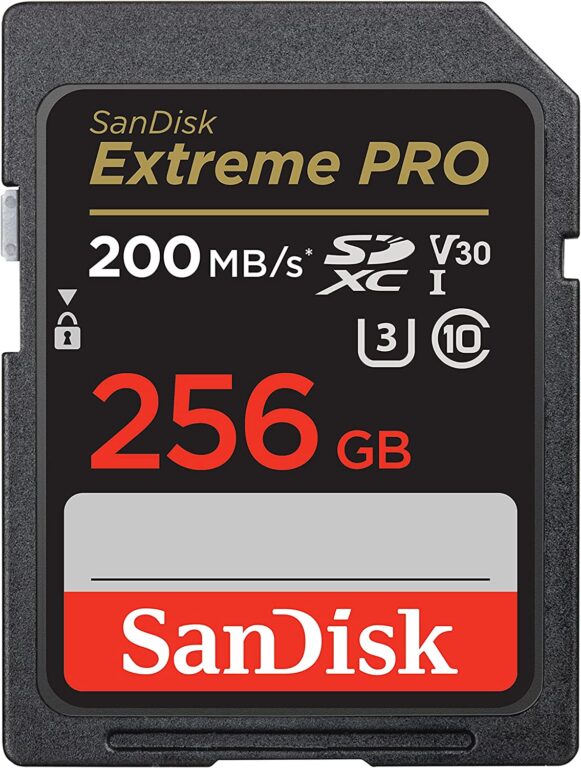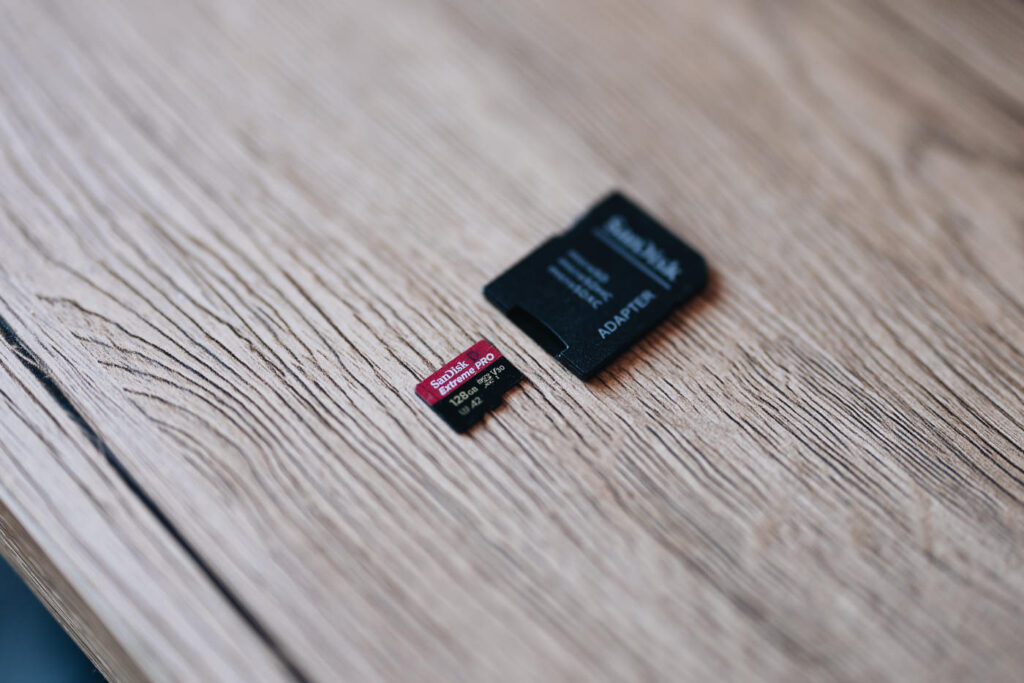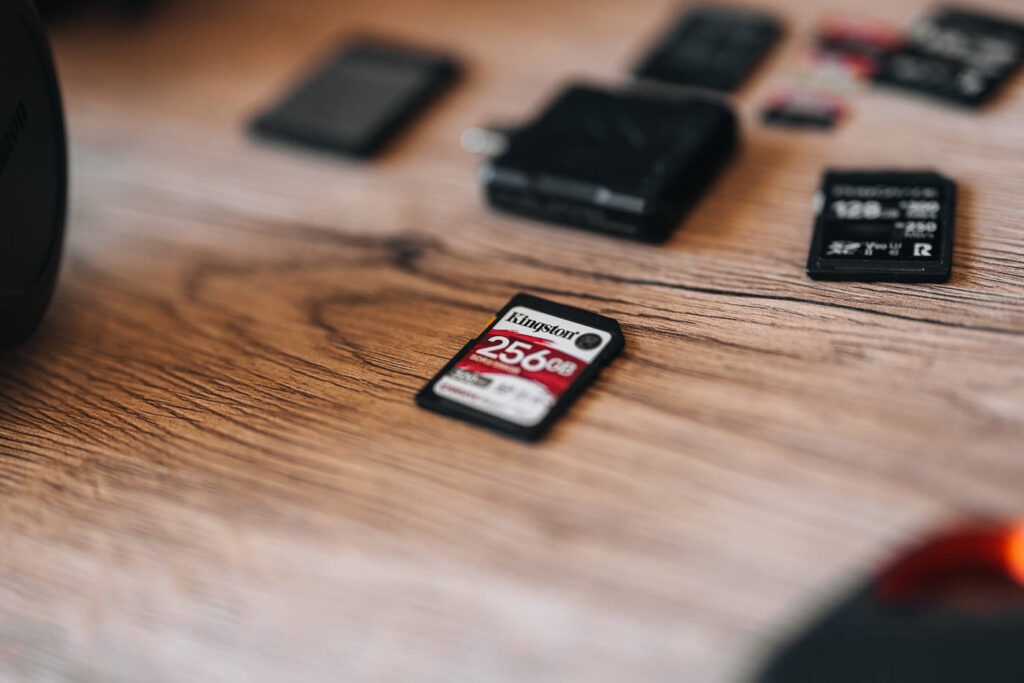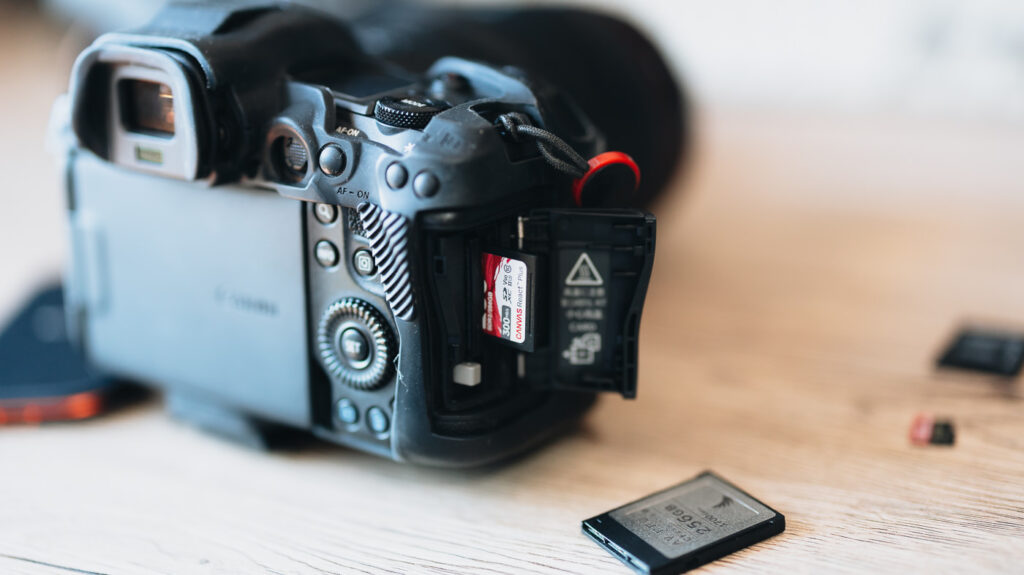From maximizing memory card read speed to keeping up with high burst rates on the latest mirrorless cameras, here is my guide to finding the best SD card for travel photography.
As a travel and adventure photographer, there’s almost nothing that I can think of that is more important than choosing the right SD card.
Think about it. We spend thousands of dollars on the finest glass and the most up-to-date mirrorless camera bodies. But, none of that accounts for anything if you have the wrong memory card for your camera– or for your specific project.
These days, digital cameras can capture dozens of high-resolution images, that’s hundreds of megabytes, every second. In addition, if you want to take advantage of the advanced features like 4K, or even 8K video recording available on the latest bodies, you’ll want to ensure you have the right SD card for your photography.
That’s why, after years of trial and error, I’ve personally selected and tested some of the best photography SD cards on the market. I’ve also included some information about the most important factors and features to look for, with specific recommendations to help you choose the best memory card for your your travel photos.
Here are my Favorite SD Cards for Travel Photography
Want the quick answer? Here are my top picks for the best SD cards in this roundup. Keep reading for a detailed breakdown of why I've recommended these cards.
- Best SD Card for speed: Kingston Canvas React Plus v90
- Best high capacity card: ProGrade v90 300R 512GB
- Decent budget SD card: SanDisk Extreme Pro V30

Roundup: The Best SD Cards for Photography
Below, I'll break down what I look for when choosing an SD Card, but first, I'll give you a quick rundown of my latest recommendations.
1. Kingston Canvas React Plus - Consistently Fast Speeds
When out shooting in the mountains or underwater, the first card I've been grabbing lately is the 256 GB Kingston Canvas React Plus.
This is a high-performance UHS-II SD card available in 32 GB, 64 GB, 128 GB, and 256 GB capacities. Designed for professional photographers and content creators, the card offers an impressive write speed of 260 MB/s and fast read speeds of 300 MB/s. As expected, it easily handles the 12 fps shutter speed on my Canon R5.
In my write speed benchmark testing (at the bottom of this post), this card achieved the fastest write speed performance of the bunch.
Kingston is also a very reputable brand in the photography space. This is crucial for me because I'm often shooting in harsh outdoor conditions where I need to trust the durability of their products.
Additionally, the V90 rating means that I can also record 4K footage straight onto this SD card. Clearly, it can't keep up with my R5's 8K RAW capabilities, but for this, I use CF cards anyway, since no SD cards on the market can meet this demand as of yet.

2. ProGrade 512GB SDXC UHS-II V90 300R - Best High-Capacity SD Card
If you're looking for a professional, high-performance SD card with the largest capacity, you'll want to check out the ProGrade 512 GB SDXC 300R.
This is ProGrade's top-of-the-line SD card, with impressive specs like 300 MB/s read and 250 MB/s write speeds in a whopping 512 GB capacity. As far as I'm aware, there are no other notable manufacturers offering this level of speed performance in a 512 GB card.
Although 512 GB of storage space may seem like overkill for some photographers, it can be an invaluable asset for those who frequently find themselves on long, multi-day shoots or need to record high-quality 4K video in addition to taking photos. This effectively doubles the shooting time before switching cards!
As expected, the ProGrade 300R performed as advertised in the benchmark tests, and I've never had buffering issues during my recent underwater shoots, where I'm constantly holding in the shutter. In addition, regular data transfer speeds and quick edits and previews using ProGrade's USB-C mobile reader are always blazing fast.

3. SanDisk Extreme Pro V30 - Best Budget SD Card for Travel Photography
The SanDisk Extreme Pro V30 is one of the most popular SD cards for hobby photographers.
Coming in a UHS-I memory card format, the SanDisk card offers shot speeds of up to 140MB/s with 200MB/s read speeds. If you're shooting on something like the Sony A6600, Sony ZV-E10, or an older DSLR camera like the Canon 5D Mark IV, then this card will be great for you, since you won't need a UHS-II card anyway.
Additionally, the SanDisk UHS-I V30 is available in capacities ranging from 32GB to 512GB, providing ample storage space for high-resolution photos and videos at a fraction of the cost of high-performance UHS-II cards.
For instance, you can pick up a 256GB variant at roughly a quarter of the cost of the V90 cards.
SanDisk is also a very reputable company in the photography space, and I use many of their products daily, including their fast hot-swap SSDs.
Furthermore, I actually used this card for years before I swapped to a full-frame mirrorless setup requiring a UHS-II card. I also still use their microSD variants for my drones, action cameras, and 360 cameras. I've never had one of these cards fail me, which is why I'm recommending them as one of the best SD cards for photographers in search for a fast, reliable, and budget-friendly UHS-I card.

4. Sony SF-G Series TOUGH UHS-II - Tough Card for Adventure Travelers
Next up we have the Sony SF-G Series TOUGH UHS-II, a top-of-the-line SD card that offers a range of advanced features and benefits for professional photographers in 32-256 GB variants.
Sony's TOUGH range of cards comes with a 10N rating, making them up to 18 times stronger than a standard SD card. Additionally, the SF-G TOUGH series has IPX6 dust-proof and IPX8 waterproof ratings, making it a great option for outdoor photographers or those shooting in harsh conditions.
While I'm hesitant to test it out, I feel like it would be hard to snap it with my bare hands, which is definitely not the feeling I get with other SD cards.
As a high-end UHS-II card, Sony claims ultra-high speeds of 300 MB/s read and up to 299 MB/s write. On paper, this would make it the fastest SD card on this list. However, in my benchmark testing, the card maxed out at around 260 MB/s with my USB C card reader, which is roughly on par with the Kingston Canvas React Plus.

5. Lexar Professional 1667x SDXC UHS-II - Mid-Range SD Card With Good Specs
Lexar Professional is another big name in the photography scene, known for offering high-quality and great value-for-money storage solutions.
As a mid-range UHS-II card, Lexar's 1667x offers read speeds of up to 250 MB/s, and write speeds of a claimed 60 MB/s minimum. While they don't advertise the maximum speed, it seemed to hover around 100 MB/s in my benchmarks.
Coming in at a sliver of the cost of the higher UHS-II cards in this roundup like the Kingston, ProGrade, and Sony makes it a very attractive SD card for hobby photographers. This is great as many will likely not need the top-performing V90 performance specs anyway.
This card can also keep up with 4K shooting demands on several modern digital cameras. But, as always it's best to check the manufacturer's advice on whether you need a V90 or a V60 card for your camera.

What to Look For When Choosing an SD Card For Travel Photography
When selecting an SD card for your camera, there are several key factors to consider. Here are some of the most important things to look for.
1. Compatibility
Before purchasing an SD card, it's essential to check the compatibility with your camera. The majority of cameras support the SD size format, while others may require the smaller microSD format. It's also a good idea to check if your camera has a slot for a compact flash card, CF express, or XQD cards.
If it's an SD card you need you next want to determine the type of SD card from the SD Standards Family. These are:
- SD cards: The original format which is now severely outdated, with a maximum storage capacity of 2 GB
- SDHC cards: A slow card standard typically used for low-resolution security cameras, with a capacity of 2GB to 32 GB
- SDXC cards: These are the SD card formats for modern digital cameras, including DSLRs and Mirrorless.
- SDUC cards: A new SD format capable of 128 TB maximum capacity and potential speeds up to 985 MB/s. Not many manufacturers or cameras are compatible with SDUC cards yet.

Additionally, as I've touched on above, some cameras may require a specific type of SD card, such as UHS-I or UHS-II to take advantage of high burst rates or high-resolution video recording. I'll go into more detail about these specs further below in the speed ratings section.
However, before you jump the gun and buy the most expensive card on the market, there is no point in buying a UHS-II card with a V90 UHS speed class rating if your camera does not support the UHS-II format.

2. Storage Capacity
Often when people start searching for an SD card for photography, they begin by considering the storage capacity. Simply put, the larger the usable memory, the more photos, and videos you can store on your card.
These days, photographers want to find SDXC cards with storage options ranging from 32 GB to 2 TB cards.
However, most photographers focusing solely on taking photos rather than video will find a 128 GB memory card sufficient. Additionally, in real-world terms, that's approximately 3200 RAW files shot with a Canon R5, which in most regular cases, is enough capacity to get to a computer to dump the files onto an SSD drive or one of your backup hard drives.
On the other hand, professional photographers on multi-day shoots, or those looking to capture video alongside their photos may require higher-capacity cards. Of course, there's always the option of simply buying more cards and swapping them out in the field, or taking advantage of the dual SD card slots or additional CF Express card slots available on higher-end mirrorless cameras and DSLRs.

Why are High Capacity SD Cards so Expensive?
As the storage on an SD card increases, so does its price. What isn't so obvious at first is that buying a single, large card, rather than two or three smaller cards to achieve the same overall storage capacity is going to be much more expensive.
This is because manufacturers require more expensive equipment for high-capacity SD cards since they need to pack a higher density into a small package.
3. Read & Write Speeds
If you ask me, read and write speeds are the two most important factors to consider when selecting an SD card for both photography and videography.
The read speed refers to how quickly data can be transferred from the card to your computer or devices like mobile phones or tablets via a Type-C card reader.
Conversely, the write speed refers to how quickly data can be written to the card, either with high burst rate photography or constant high-resolution video recording. For photographers, write speed is the more important metric.

Understanding Class Rating on SD Cards
In an attempt to make things easier, SD card manufacturers have implemented class rating systems according to their write speed. However, most photographers find that this just makes it more confusing.
Since we're stuck with these ratings, let's dig into what they mean, and what photographers need to look for when choosing an SD card for their cameras.

These days, most modern digital cameras require a minimum speed class mark of a Class 10 rating, translating to a minimum write speed of 10 MB/s. However, considering a single RAW file using full-frame mirrorless cameras like the Canon R5 or Sony A7 IV can be over 50 megabytes each, photographers are going to need more performance than this.
That's why it's more important to look at the UHS speed class ratings.
Generally speaking, most cameras these days require a UHS-I or UHS-II compatibility, with a UHS speed class rating of U3, translating to minimum write speeds of 30MB/s.
The final symbol on the card is the UHS video speed class. For most cameras, you should be looking at a rating between V30 and V90 for photography, especially if you want to take advantage of your camera's burst mode.

Benchmarking Results
Below are the average write and read speeds after benchmarking all five of the above SD cards using Blackmagic's Disk Speed tool on the highest stress settings using my Macbook Pro's inbuild UHS-II reader.
All cards were newly formatted using my Canon EOS R5.
| SD Card | Avg. Write Speed | Avg. Read Speed |
|---|---|---|
| Kingston Canvas React Plus 256GB UHS-II | 252 MB/s | 275 MB/s |
| ProGrade 512GB SDXC UHS-II | 243 MB/s | 273 MB/s |
| SanDisk Extreme Pro 128GB UHS-I | 137 MB/s | 157 MB/s |
| Sony SF-G Series TOUGH 256GB UHS-II | 250 MB/s | 280 MB/s |
| Lexar Professional 1667x SDXC UHS-II | 112 MB/s | 226 MB/s |
This test benchmarks sequential write speed and sequential read speed. This is the measure of how quickly large files are able to be written onto or transferred from the SD card. This pattern is the best metric for photography, since random read and write, are more suitable for applications such as devices running an operating system.

4. Durability & Brand Reputation
As a photographer, few things are more frustrating and disappointing than discovering a corrupt SD card. It can be a nightmare to realize that all the time, effort, and creativity may have gone to waste.
Therefore, for peace of mind when choosing an SD card, you'll want to ensure that you are buying from a reputable brand. The top manufacturers like Kingston, ProGrade, and SanDisk use high-quality materials in order to ensure the durability and longevity of the card.
Unfortunately, there are a lot of fake SD cards on the market, especially floating around on Amazon. Therefore, I recommend buying only from the brand's Amazon store or from a reputable reseller. All of the links on this post lead to the official Amazon store.

5. Budget
Finally, your budget. When it comes to price, it's essential to find a balance between cost and quality.
While it may be tempting to opt for the cheapest SD card available, it's important to keep in mind that you've likely already invested a significant amount of money into your camera body. Going for a cheap SD card is like putting low-quality fuel into a high-performance car– you won't get the maximum power or efficiency that the car is capable of.
On the flip side, purchasing jet fuel for your Toyota Corolla wouldn't make much sense either. Not all cameras are able to fully take advantage of the higher-end speed rating specifications, especially those found in the UHS-II format.
While it's important to invest in a high-quality SD card that is compatible with your camera, it's equally important to choose a card that aligns with your camera's capabilities. Going for the top-of-the-line SD card may not necessarily provide any additional benefits if your camera isn't able to fully utilize its features.

More Travel Photography Gear Guides
I hope you've enjoyed this up-to-date gear guide on finding the best sd card for photography.
If this guide has helped you choose the right memory card for your camera, then make sure to check out some of my other photography gear guides below. I'm always updating my guides and often publishing new gear advice from my several years of working as a travel photographer.



Lin Calleja
Thursday 18th of May 2023
Thanks for your info and clarification on sd cards. I've tried so many over the years and had so many different results but no actual photogragher/user to chat to or compare with. Your article has helped a lot especially with which is more important out of read and write speeds. Thanks.